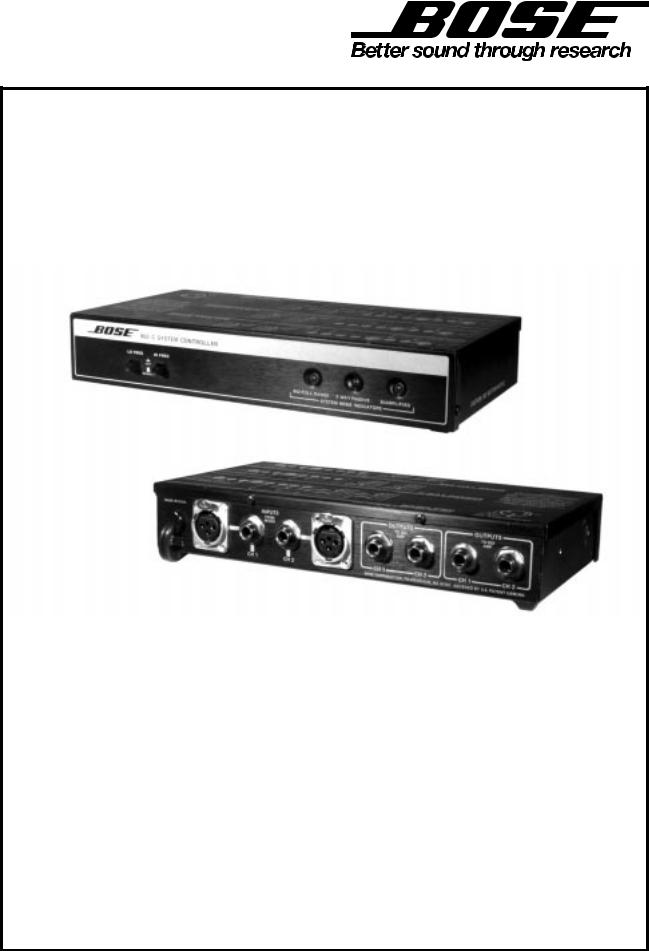Bose 802c User Manual

®
®
802C System Controller
Original and SMD Version
Units with serial numbers beginning with 100000 are the original 802C's. Units with serial numbers beginning with 200000 are the new SMD 802C's.
©1997 Bose Corporation Service Manual
1 |
Part Number 129292 REV 03 |
|
|
Contents |
|
Safety Information ............................................................................................................................ |
3 |
|
Electrostatic Discharge Sensitive (ESDS) Device Handling ........................................................ |
4 |
|
Specifications ................................................................................................................................... |
5 |
|
Technical Description ...................................................................................................................... |
6 |
|
Disassembly/Assembly Procedures .............................................................................................. |
7 |
|
Figure 1. |
Locking Tab Screw Location ............................................................................................. |
7 |
Figure 2. |
Original 802C PCB Exploded View ................................................................................... |
8 |
Figure 3. |
SMD 802C PCB Exploded View ....................................................................................... |
8 |
Test Procedures .......................................................................................................................... |
9-10 |
|
Part List Notes ................................................................................................................................ |
11 |
|
Main Part List .................................................................................................................................. |
12 |
|
Figure 4. Main Parts Exploded View .............................................................................................. |
13 |
|
Electrical Part List ..................................................................................................................... |
14-17 |
|
Voltage Conversion Instructions .................................................................................................. |
18 |
|
Figure 5. Voltage Conversion Diagram .......................................................................................... |
18 |
|
Figure 6. |
Top Cover Connection Diagram ...................................................................................... |
19 |
2

SAFETY INFORMATION
1. Parts that have special safety characteristics are identified by the |
|
|
symbol on |
|
|
schematics or by special notes on the parts list. Use only replacement parts that have critical characteristics recommended by the manufacturer.
2.Make leakage current or resistance measurements to determine that exposed parts are acceptably insulated from the supply circuit before returning the unit to the customer. Use the following checks to perform these measurements:
A.Leakage Current Hot Check-With the unit completely reassembled, plug the AC line cord directly into a 120V AC outlet. (Do not use an isolation transformer during this test.) Use a leakage current tester or a metering system that complies with American National Standards Institute (ANSI) C101.1 “Leakage Current for Appliances” and Underwriters Laboratories (UL) 1492 (71). With the unit AC switch first in the ON position, then in the OFF position, measure from a known earth ground (metal water pipe, conduit, etc.) to all exposed metal parts of the unit (antennas, handle bracket, metal cabinet, screwheads, metallic overlays, control shafts, etc.), especially any exposed metal parts that offer an electrical return path to the chassis. Any current measured must not exceed 0.5 milliamp. Reverse the unit power cord plug in the outlet and repeat test. ANY MEASUREMENTS NOT WITHIN THE LIMITS SPECIFIED HEREIN INDICATE A POTENTIAL SHOCK HAZARD THAT MUST BE ELIMINATED BEFORE RETURNING THE UNIT TO THE CUSTOMER.
B.Insulation Resistance Test Cold Check-(1) Unplug the power supply and connect a jumper wire between the two prongs of the plug. (2) Turn on the power switch of the unit. (3) Measure the resistance with an ohmmeter between the jumpered AC plug and each exposed metallic cabinet part on the unit. When the exposed metallic part has a return path to the chassis, the reading should be between 1 and 5.2 Megohms. When there is no return path to the chassis, the reading must be “infinite”. If it is not within the limits specified, there is the possibility of a shock hazard, and the unit must be repaired and rechecked before it is returned to the customer.
PROPRIETARY INFORMATION
THIS DOCUMENT CONTAINS PROPRIETARY INFORMATION OF BOSE® CORPORATION WHICH IS BEING FURNISHED ONLY FOR THE PURPOSE OF SERVICING THE IDENTIFIED BOSE PRODUCT BY AN AUTHORIZED BOSE SERVICE CENTER OR OWNER OF THE BOSE PRODUCT, AND SHALL NOT BE REPRODUCED OR USED
FOR ANY OTHER PURPOSE.
3
ELECTROSTATIC DISCHARGE SENSITIVE (ESDS)
DEVICE HANDLING
This unit contains ESDS devices. We recommend the following precautions when repairing, replacing or transporting ESDS devices:
•Perform work at an electrically grounded work station.
•Wear wrist straps that connect to the station or heel straps that connect to conductive floor mats.
•Avoid touching the leads or contacts of ESDS devices or PC boards even if properly grounded. Handle boards by the edges only.
•Transport or store ESDS devices in ESD protective bags, bins, or totes. Do not insert unprotected devices into materials such as plastic, polystyrene foam, clear plastic bags, bubble wrap or plastic trays.
CAUTION: THE 802® C SYSTEM CONTROLLER CONTAINS NO USER-SERVICEABLE PARTS. TO PREVENT WARRANTY INFRACTIONS, REFER SERVICING TO WARRANTY SERVICE STATIONS OR FACTORY SERVICE.
4

|
|
SPECIFICATIONS |
||
Input Connections: |
|
|
|
One (1) balanced female XLR connector |
|
|
|||
(per channel) |
|
|
|
One (1) unbalanced 1/4" phone jack |
Output Connections: |
|
|
|
Two (2) 1/4" phone jacks per channel |
(per channel) |
|
|
|
(outputs used depend upon mode selected) |
Input Impedance: |
|
|
|
Balanced input, 4kΩ |
|
|
|
|
Unbalanced input, 42kΩ |
Electronic Crossover |
|
|
|
|
Frequency: |
|
|
|
180Hz (bi-amplified mode only) |
Maximum Output Level: |
|
|
|
4 Volts (+12dB into 600Ω, 50Hz-16kHz) |
Total Harmonic Distortion: |
|
|
|
Less than .02% at 1 Volt (0dB) |
|
|
|
|
Less than .2% at 8 Volts (18dB) |
Output Noise: |
|
|
|
Less than 20uV (-9dBV) A-weighted |
Power Requirements: |
|
|
|
120 Vac, 50-60Hz, 3.5 Watts |
|
|
|
|
220 Vac, 50-60Hz, (European) |
|
|
|
|
100 Vac, 50-60Hz, (Japan) |
Dimensions: |
|
|
|
1 3/4"H x 10" W x 5" D |
|
|
|
|
(4.4 x 25.4 x 12.7 cm) |
Weight: |
|
|
|
1.97 lbs (.895 kg) |
5
TECHNICAL DESCRIPTION
The 802® C System Controller is a sophisticated signal processing device which combines the functions of three equalizers, an automatic switching circuit, and an electronic crossover. The 802C system controller automatically selects the proper crossover function and equalization curve for a given system application through use of a switching network operating in conjunction with the unit's output jacks. In addition to signal routing based on equalization requirements, the switching network indicates mode of operation on its front panel. The front panel also includes high-cut and low-cut switches which decrease line output by 4dB at 55Hz and by 10dB at 16kHz. Sharp subsonic and ultrasonic band-limiting filters reduce power waste, stage noise, high-frequency instability, and interference. The 802C system controller retains the compact dimensions of its predecessor, the Bose® 802E active equalizer, and fits into one space of a standard 19" equipment rack with the optional RMK-8 Rack Mount Kit.
In an on-going process of manufacturing updates, as technology permits, Bose Corporation has begun using SMD (surface mount devices) components on its 802C controller. The new SMD components are such a space saving feature that this new version permits us to eliminate the "piggy-back" PCB and place all electronics on one single printed circuit board. This manual will identify the different procedures, PCB layouts, and components where necessary.
There is no difference in the operation or function between the original 802C and the 802C SMD units.
6
